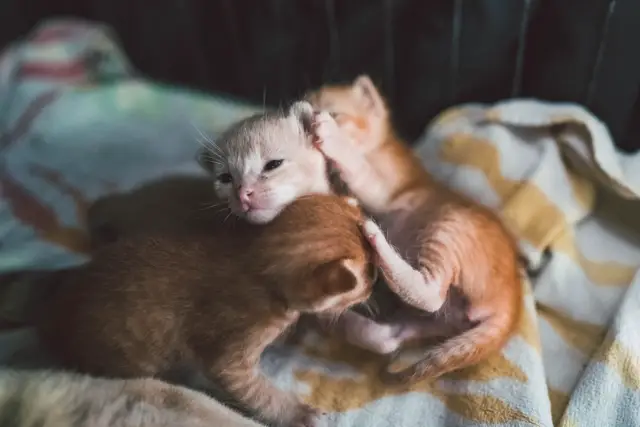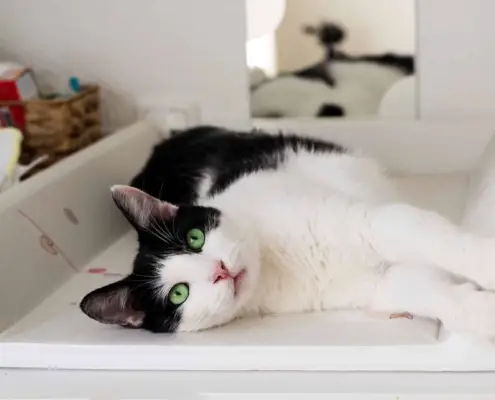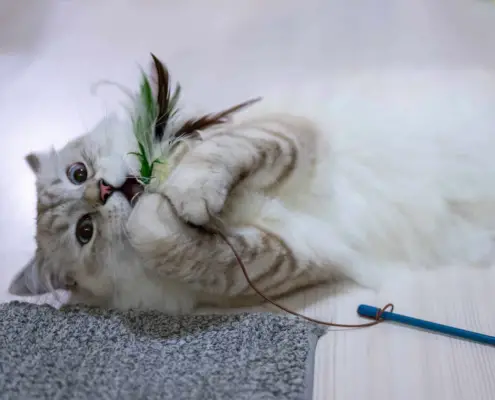
Cat zoomies, also known as the “crazy hour,” refer to those sudden bursts of energy that cats exhibit. During this time, cats engage in high-speed running, jumping, and playful behavior. It is a common sight to see cats darting around the house, chasing invisible prey, and leaping from furniture to furniture. These episodes of hyperactivity can last for a few minutes to over an hour, leaving both cats and their owners entertained and sometimes a little bewildered.
Why do cats get zoomies?
The exact reason behind cat zoomies is not fully understood, but there are several theories. One reason could be the pent-up energy that builds up in cats due to their sedentary lifestyle. Cats are natural hunters, and when confined indoors, they may not have enough outlets to expend their energy. Additionally, cats are crepuscular animals, meaning they are most active during dawn and dusk. When these twilight hours coincide with their owners’ return from work or bedtime routines, cats may become excited and display zoomies as a way to release their energy.
The science behind cat zoomies
Cats have evolved as apex predators, and their zoomies can be seen as an evolutionary trait. The sudden bursts of energy simulate hunting behavior, allowing them to stay sharp and ready for action. When cats engage in zoomies, several physiological changes occur within their bodies. Adrenaline is released, increasing their heart rate and blood flow. This surge of energy triggers the “fight or flight” response, preparing cats for any potential threats. The release of endorphins during these episodes also contributes to their euphoric behavior.
Common triggers for cat zoomies
Cat zoomies can be triggered by various factors. One common trigger is the presence of other animals, particularly if they are perceived as prey or competition. A glimpse of a bird through the window or the sound of a squirrel scratching on a tree can spark a zoomie session. Another trigger is environmental stimulation, such as sudden loud noises or changes in the household routine. Cats are creatures of habit, and any disruption to their familiar surroundings can lead to an energetic outburst. Lastly, boredom and lack of mental stimulation can also cause zoomies. Cats that do not have enough toys, scratching posts, or interactive playtime may resort to zoomies as a way to entertain themselves.
How to manage cat zoomies
While cat zoomies can be entertaining, they can also be disruptive, especially if they occur during the night or in small living spaces. Fortunately, there are ways to manage and redirect this behavior. Providing cats with regular play sessions, particularly interactive play that simulates hunting, can help release their energy in a more controlled manner. Engaging toys, such as feather wands or laser pointers, can keep cats mentally and physically stimulated. Additionally, establishing a consistent routine for feeding, playtime, and rest can help reduce the likelihood of zoomie episodes.
Tips for preventing cat zoomies
Preventing cat zoomies altogether may not be possible, but there are strategies that can minimize their occurrence. Ensuring that cats have access to vertical spaces, such as cat trees or shelves, allows them to engage in climbing and jumping activities. This not only provides an outlet for their energy but also promotes exercise and mental stimulation. Providing a variety of toys, scratching posts, and puzzle feeders can keep cats entertained and prevent boredom-induced zoomies. Finally, allowing cats access to safe outdoor spaces, such as enclosed gardens or catio enclosures, can provide them with additional opportunities for exercise and exploration.
Fun ways to engage with your cat during zoomies
Instead of being a passive observer, you can actively participate in your cat’s zoomie sessions. One way to engage with your cat is by using interactive toys. Dangling a feather wand or dragging a string across the floor can simulate prey-like movements, encouraging your cat to chase and pounce. You can also create obstacle courses using cardboard boxes, tunnels, and furniture to provide a stimulating environment for your cat’s zoomies. Another fun activity is to hide treats or toys around the house, encouraging your cat to engage in a “treasure hunt” during their burst of energy.
Are cat zoomies a cause for concern?
In most cases, cat zoomies are a normal and healthy behavior. However, it is essential to differentiate between normal zoomies and signs of distress or anxiety. If your cat’s zoomies are accompanied by excessive vocalization, aggression, or destructive behavior, it may indicate an underlying issue. In such cases, it is advisable to consult a veterinarian or a professional animal behaviorist to evaluate your cat’s behavior and provide appropriate guidance.
Cat zoomies and exercise
Cat zoomies should not be seen as a substitute for regular exercise. While these energetic episodes can provide a temporary release of energy, cats still require daily exercise to maintain their physical and mental well-being. Interactive play sessions, such as chasing toys or engaging in puzzle feeders, can help cats burn calories, strengthen their muscles, and keep their minds sharp. Additionally, providing opportunities for outdoor exploration, under safe and supervised conditions, can offer cats a more extensive range of physical activities.
Conclusion
Cat zoomies are a fascinating and entertaining aspect of feline behavior. Understanding their triggers and providing appropriate outlets for your cat’s energy can help manage and redirect this behavior. By engaging in interactive play, creating stimulating environments, and ensuring regular exercise, you can help your cat lead a fulfilling and balanced life. So, the next time your cat enters the whirlwind world of zoomies, embrace the chaos and enjoy the delightful display of feline energy.
If you enjoyed my article, I would appreciate you sharing it with your network.

Sima Ndlebe
Sima writes for CatBuzz. He is interested in Cats, Health and Fitness, and Entrepreneurship.
Published: 17 November 2023



